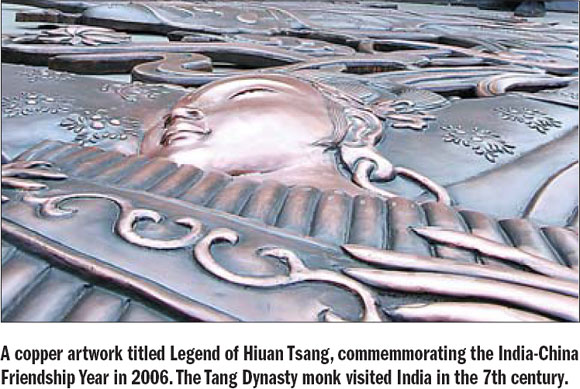China plus India equals global leadership

The 21st century began with a global focus on China and India. These continent-sized countries, each with over one billion people, are currently the world's fastest growing economies.
The spectacular economic growth of China for over 20 years and that of India in the last decade or more is largely due to business outsourcing by the developed world; hardware to China and software to India.
Today, China has become the "factory of the world" and India is getting to be its "back office." Both appear to be going from strength to strength as domestic business also grows dramatically along with the buying power of the two peoples.
Both countries have been age-old partners and friends. The bonds between China and India run deep with old cultural and religious ties. Business and religion have kept the two nations together for centuries.
After a gap of years of foreign rule, Sino-Indian friendship was reinstated after both won their independence in the late 1940s. While most of the nations did not recognize China's communist government then, India was among the first countries to recognize China in spite of global resistance.
Former Indian Premier Jawaharlal Nehru's call of "Hindi-Chini Bhai-Bhai" - India and China are brothers - was therefore reciprocated by the Chinese leadership.
However, the unfortunate border dispute and resulting military conflict in 1962 replaced that camaraderie with years of rather cold relations, mainly restricted to diplomatic exchanges.
Then, after a 34-year hiatus, Indian Prime Minister Rajiv Gandhi paid an official visit to China in December 1988 at the invitation of Premier Li Peng.
With this major event, India-China relations began normalizing again, and Prime Minister Gandhi's meeting with late Chairman of Central Military Commission Deng Xiaoping was an event that received worldwide attention.
The two sides emphasized that the Five Principles of Peaceful Coexistence (called Panchsheel in Hindi) jointly initiated by China and India in 1954 were indeed the fundamental principles guiding bilateral relations as well as the establishment of a new international political and economic order.
The Five Principles once again became a shared approach of both countries, thereby exerting a positive impact on peace and stability in Asia and the world.
Prime Minister Atal Bihari Vajpayee's visit to China in 2003 came a decade after Prime Minister Narasimha Rao's visit. Both visits further strengthened bilateral relations.
Rapid trade growth is encouraging closer people-to-people contact, a vital link in developing warmer ties.
The India China Economic and Cultural Council, or ICEC Council, has organized several bilateral business and cultural meetings, and conferences, further contributing to closer interaction.
The two countries celebrated 2006 as India-China Friendship Year with many significant events. In July that year, after a gap of 44 years, the two nations reopened Nathu La, a mountain pass connecting Tibet to Sikkim, for trade. This was a landmark step in terms of bilateral relations.
President Hu Jintao and Premier Wen Jiabao visited India in 2005 and 2006 respectively, in order to forge new links.
Armies of the two countries have held joint military exercises. They are closely cooperating at the WTO negotiations, especially on issues like international trade in agricultural products and intellectual property rights (IPR). Sonia Gandhi, chairwoman of the United Progressive Alliance (UPA), visited China last October and Prime Minister Manmohan Singh begins the new year by visiting Beijing from January 13 to 15.
Plus, not minus
The "India plus China" mood is growing in both countries.
Some people wonder whether India can ever catch up with China, pointing out China's remarkable achievements in infrastructure and manufacturing. Some others are apprehensive that the coming together of the two nations' corporate giants could pose a threat to Western multinationals.
But most Indians and Chinese seem to think differently. The cynics forget that neither India nor China has ever displayed any imperialist ambition in thousands of years of history, even when they were at their strongest.
Both nations know that they have important matters to handle like alleviation of rural poverty and enhancement of productivity, rather than confront each other militarily.
It is being increasingly realized that in the long run, and for several valid reasons, India and China are better off as friendly neighbors, rather than being antagonists and suspicious of each other. The time is right for both to get rid of any past mistrust since times now are completely different in economic and political terms.
With the growing purchasing power of their people, domestic business is booming. Unlike the Western world, India and China have large young populations, creating the capacity to man large global businesses throughout this century.
The author is president of the India China Economic and Cultural Council
(China Daily 01/14/2008 page17)














